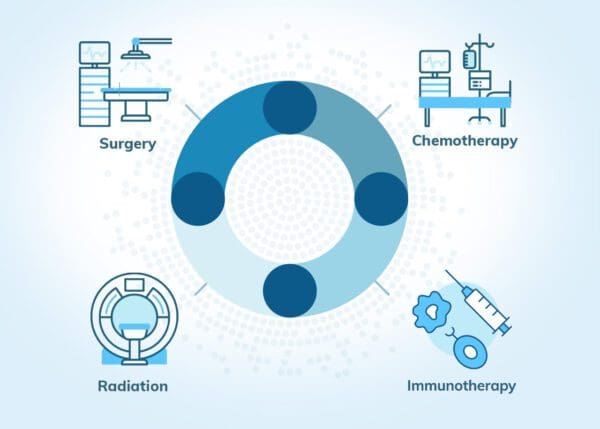01. Overview of Multimodal Therapy
What Is Multimodal Therapy for Mesothelioma?
Multimodal treatment for mesothelioma combines multiple therapies in one treatment plan. This approach may be most effective at extending survival. Mesothelioma multimodal therapy often includes chemotherapy, surgery and/or radiation. Newer therapies, such as immunotherapy, may also be used in combination treatment plans.
This approach arose after single modality treatments failed to sufficiently improve survival. Doctors combined therapies in an effort to address the shortcomings of individual therapies.
Multimodal treatment has extended mesothelioma life expectancy versus singular treatments. Some experts have indicated multimodal treatment constitutes the best chance for a mesothelioma cure.
Multimodal treatment approaches may incorporate additional therapies before or after the primary treatment. Trimodality treatment does both. It may consist of chemotherapy followed by surgery and radiation.
Multimodal treatment lets patients benefit from the strengths of multiple individual therapies. This approach may allow one treatment to make up for the shortcomings of another. For example, chemotherapy may help kill cancer cells that remain after surgery.
Resources for Mesothelioma Patients
02. How Multimodal Treatment Works
How Does Multimodal Therapy Treat Mesothelioma?
Multimodal therapy treats mesothelioma with a combination of therapies. Together, the treatments use multiple methods to inhibit or kill mesothelioma cells. This strategy may make the overall treatment plan more effective.
One common multimodal mesothelioma treatment approach combines surgery with chemotherapy. During mesothelioma surgery, a doctor attempts to remove as much tumor tissue as possible. However, the surgeon may not be able to see microscopic cells left behind. Chemotherapy administered after surgery may be able to address these remaining cancer cells.
Mesothelioma doctors can incorporate any number of individual treatments in a multimodal plan. This means treatment can be customized to the needs of the individual patient. Doctors consider various things when recommending a treatment plan. These may include mesothelioma type, stage at diagnosis and patient health.
Experts do not currently agree on an optimal approach to multimodal treatment for mesothelioma. However, research into that topic is ongoing.
Emerging Treatments in Multimodal Therapies
Mesothelioma research covers many different treatment approaches, including multimodal therapy. Some investigators have explored combining experimental treatments with more standard options. Studies have investigated the following methods:
- Cancer vaccines: Cancer treatment vaccines teach the immune system to recognize and attack cancer cells. They may be considered a form of immunotherapy.
- Cryotherapy: Cryotherapy uses extremely cold gas or fluid to kill cancer cells.
- Photodynamic therapy: Photodynamic therapy uses light and a light-responsive drug to kill cancer cells.
- Tumor treating fields (TTFields): A medical device called the Optune Lua™ administers TTFields. TTFields apply mild electrical currents to disrupt cell division. This may slow or stop cancer growth.
Doctors have investigated these therapies through mesothelioma clinical trials. Such clinical research can expand multimodal treatment options and improve survival.
03. Multimodal Therapy by Type
Multimodal Treatment by Mesothelioma Type
Multimodal mesothelioma treatment varies according to the patient’s type of mesothelioma. This is due to the distinct properties of each form of mesothelioma. Factors affecting multimodal treatment choice include:
- Overall patient health
- Treatment center qualifications
- Tumor location
- Stage of cancer
Treatments such as radiation may work differently in pleural versus peritoneal cases. Individual therapies may prove beneficial in one location but lackluster in the other. As a result, oncologists may include some treatments for pleural mesothelioma but not for peritoneal.
Decades of research have attempted to optimize combinations of mesothelioma treatments. In that time, some approaches have come to the forefront. Doctors often treat the main types of mesothelioma with surgery and chemotherapy. However, many options exist for multimodal mesothelioma treatment.
Multimodal Treatment for Pleural Mesothelioma
Multimodal therapy for pleural mesothelioma commonly combines two or three treatments. The ultimate combination depends on the patient’s eligibility for surgery.
Patients with operable pleural mesothelioma have two common surgical options.
- Extrapleural pneumonectomy (EPP): EPP is an extensive operation. It removes the pleura and the affected lung. EPP also removes cancerous parts of the diaphragm and heart lining.
- Pleurectomy/decortication (P/D): P/D is considered a lung-sparing procedure. It removes the pleura and any tumors on the surface of the lung. P/D does not remove the lung on the affected side. Some forms of P/D may also remove tumors on the diaphragm or heart lining.
Both EPP and P/D have been used in effective multimodal treatment plans.
Inoperable pleural mesothelioma patients may receive chemotherapy and immunotherapy. This multimodal approach extended survival in a clinical trial. Patients received standard chemotherapy with or without bevacizumab. Bevacizumab is an immunotherapy drug known by its brand name, Avastin®. It extended survival by almost 20% versus chemotherapy alone.
Multimodal Treatment for Peritoneal Mesothelioma
Multimodal therapy for peritoneal mesothelioma commonly combines surgery and chemotherapy. Doctors refer to this surgical procedure as cytoreductive surgery (CRS). During CRS, doctors remove visible mesothelioma tumors.
After CRS, patients often receive some form of local chemotherapy. This means the chemotherapy only goes into the abdomen, rather than circulating systemically.
One of the most common forms of local chemotherapy is called HIPEC. HIPEC stands for hyperthermic intraperitoneal chemotherapy. It is a heated chemotherapy treatment administered within the abdomen.
Combination therapy with CRS and HIPEC has helped some patients achieve long-term survival. Multimodal approaches using other forms of local chemotherapy have also positively impacted prognosis.
Doctors may use this multimodal treatment therapeutically. The treatment may help the patient recover from mesothelioma. CRS and HIPEC can also provide palliative treatment for mesothelioma patients.
04. Multimodal Treatment Prognosis
Mesothelioma Survival and Prognosis After Multimodal Therapy
Several multimodal therapies have extended mesothelioma survival beyond the common range of 18 to 31 months. Mesothelioma prognosis with multimodal therapy depends on several factors, including:
- Mesothelioma cell type
- Patient factors
- Stage at diagnosis
- The treatment combination
Some multimodal approaches have achieved better survival than others. Survival after multimodal treatment generally ranges from one to three years in pleural mesothelioma. In peritoneal mesothelioma, multimodal therapy has extended survival beyond six years for some patients.
Multimodal Treatment and Long-Term Survival in Mesothelioma
Medical literature indicates some multimodal approaches have achieved long-term survival. One study treated pleural mesothelioma patients with chemotherapy and P/D. Nearly one third of study patients lived five years or longer.
A small peritoneal mesothelioma study treated patients with CRS and HIPEC. Patients also received at least three cycles of intra-abdominal chemotherapy. All study patients survived at least eight years. One patient survived 19 years or more.
Mesothelioma patients should discuss treatment options with an oncologist. The cancer specialist can help determine the best approach for the patient’s individual needs.
05. Multimodal Treatment Side Effects
Side Effects of Multimodal Treatment for Mesothelioma Patients
Multimodal mesothelioma treatment can cause a range of side effects. This trait is shared among most cancer treatments. Side effects for mesothelioma will vary based upon the individual treatments in a given plan.
The cancer care team can effectively manage many side effects. Patients may help in this effort by sharing any adverse reactions with their doctors. Patients may also benefit from palliative care. Palliation can help patients manage side effects and quality of life at all stages of the cancer journey.
06. Multimodal Treatment Process
The Mesothelioma Multimodal Treatment Process and Experience
Each patient may have a unique multimodal treatment experience. The details of the process can vary based upon individual patient factors and treatments. However, multimodal treatment plans share some general steps, including:
- Diagnosis and staging of mesothelioma
- Careful consideration of patient factors to determine the best treatment approach
- Treatment with neoadjuvant, primary and adjuvant treatments where applicable
- Side effect or symptom management
- Monitoring for cancer progression or return
Researchers have made progress in second-line treatment of mesothelioma. This means patients still have options even if the cancer returns after multimodal treatment.
For example, one recent study successfully added immunotherapy as a second-line treatment. Study patients had received up to six therapies before enrolling. In the study, patients received a combination immunotherapy treatment. It consisted of CAR T cells and a checkpoint inhibitor called Keytruda® (pembrolizumab).
Patients had a median survival of about two years. This marks an improvement of more than one year versus prior second-line treatments. This study also demonstrates the flexibility of multimodal treatment approaches.
07. Eligibility for Multimodal Treatment
Who Is Eligible for Multimodal Mesothelioma Treatment?
Eligibility for multimodal mesothelioma therapy depends on several factors, including:
- Mesothelioma stage
- Patient health
- Tumor location
For instance, mesothelioma doctors recommend multimodal treatment for pleural mesothelioma patients in stages 1 – 3 and in good overall health. Patients with a poor performance or functional status may not be candidates for multimodal therapy.
Any mesothelioma patient interested in multimodal treatment should discuss it with their oncologist. A mesothelioma specialist can provide an informed evaluation of eligibility criteria.
08. Common Questions
Common Questions About Multimodal Therapy for Mesothelioma
-
What are the benefits of multimodal therapy for mesothelioma?
-
- Experts say multimodal treatment offers “the best chance for a cure” for mesothelioma.
- Multimodal approaches are flexible. This means doctors can tailor them to the needs of each individual patient.
- Single treatments have failed to meaningfully improve survival in the past. Multimodal approaches have proven more effective.
-
What is the difference between single modality and multimodal treatment for mesothelioma?
- Single modality mesothelioma treatment consists of only one therapy. A patient receiving only systemic chemotherapy is undergoing single-modality treatment. Multimodal treatment combines more than one single modality treatment. A common multimodal treatment for mesothelioma consists of surgery and chemotherapy.
-
Who is eligible for multimodal mesothelioma treatment?
- Patient eligibility depends on the patient’s specific case. Multimodal treatments involving surgery are generally available to patients with operable mesothelioma. Patients with inoperable mesothelioma often qualify for chemotherapy and immunotherapy treatment.










